The Dallas Guitar Festival

On Sunday I visited the Annual Dallas Guitar Festival, or, as it used to be called, “The Guitar Show”.
There were thousands of unique and vintage guitars and tons of amps and special effects, and all sorts of great gear. As a guitarist, it’s always wonderful to see that stuff and learn about it and play with it and try it out. There were some really fantastic guitars there. These are the kinds of guitars that you can never find in the major guitar stores. 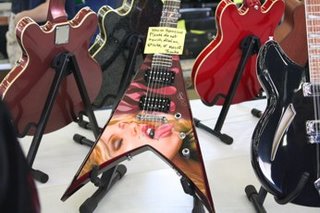 This sexy-looking flying V-style one has a handwritten sign on it that says, "No touching, playing, drooling on, stroking, or mounting this guitar." There were others with amazing paint jobs, and some that were even scuplturessuch as this one from the Dimebag Darrell Art Collection.
This sexy-looking flying V-style one has a handwritten sign on it that says, "No touching, playing, drooling on, stroking, or mounting this guitar." There were others with amazing paint jobs, and some that were even scuplturessuch as this one from the Dimebag Darrell Art Collection.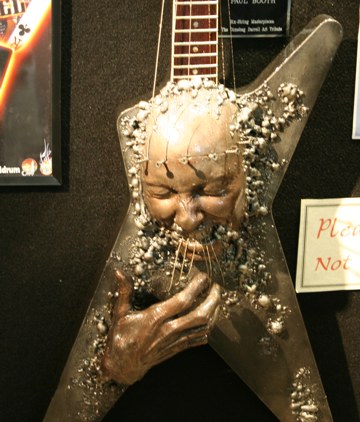 Normally, you can go from one retail store to the next, and just see the all the same new guitars of the same major brand names, Fender, Gibson, PRS, Epiphone, Taylor, Martin, Gretch, Guild, etc.,
Normally, you can go from one retail store to the next, and just see the all the same new guitars of the same major brand names, Fender, Gibson, PRS, Epiphone, Taylor, Martin, Gretch, Guild, etc.,  but you never seem to come across a vintage 1961 Strat for $10,000, or a vintage National guitar, No D’Angelico New Yorker or custom handmade guitars like Minarek (shown above) or Warrior guitars, or other rare custom one-off's like the left hand one shown below being played by the luthier that built it, and brought it to the show to sell. In stores you don’t see a Breedlove acoustic, and you certainly don’t see a 1957 Gibson Les Paul for over $100,000.
but you never seem to come across a vintage 1961 Strat for $10,000, or a vintage National guitar, No D’Angelico New Yorker or custom handmade guitars like Minarek (shown above) or Warrior guitars, or other rare custom one-off's like the left hand one shown below being played by the luthier that built it, and brought it to the show to sell. In stores you don’t see a Breedlove acoustic, and you certainly don’t see a 1957 Gibson Les Paul for over $100,000.
But here at the show, suddenly all these rare guitars come out of the woodwork (so to speak), and they are fascinating to see and touch and play and hear.
But frankly, the real reason I go to the Guitar Show is to see the performances of famous guitar players. The list is simply too long to put here, but my favorites are Phil Keaggy, and especially Johnny A.
Last year, I was late and just caught the last 10 minutes of Johnny A’s performance, but this year I was there in plenty of time.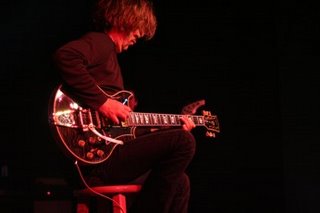

He is a fantastic player, and he put on a great show with only a bassist and drummer. But this time, he was a bit late getting started. Johnny was getting a little perturbed by their delays in getting things setup, and you can see that in this picture. He had great technique and good energy, and he and his band were very tight as usual. Johnny is a remarkable talent no matter which style of guitar playing you prefer, and I was amazed at the variety of different excellent tones he gets out of that Gibson Johnny A signature guitar. The one that the public can buy always seems to have a sunburst finish, but I've only ever seen him play this one with a transparent black finish over a flamed maple top, and gold-metallic sides and back. His playing seemed like effortless vurtuosity. Also, he sits on a stool instead of standing up. He is a man of small stature, so I suppose that camoflages that fact. Nevertheless, he seems to move more, and to be more animated than many other guitarists that stand and walk around. He somehow manages to sit at one place but still rock and move around. It would be worth it to get his DVD.
He had great technique and good energy, and he and his band were very tight as usual. Johnny is a remarkable talent no matter which style of guitar playing you prefer, and I was amazed at the variety of different excellent tones he gets out of that Gibson Johnny A signature guitar. The one that the public can buy always seems to have a sunburst finish, but I've only ever seen him play this one with a transparent black finish over a flamed maple top, and gold-metallic sides and back. His playing seemed like effortless vurtuosity. Also, he sits on a stool instead of standing up. He is a man of small stature, so I suppose that camoflages that fact. Nevertheless, he seems to move more, and to be more animated than many other guitarists that stand and walk around. He somehow manages to sit at one place but still rock and move around. It would be worth it to get his DVD. After only playing for 30 minutes, the people who run the stages were concerned about the schedule, so they were signaling him offstage to wrap it up. Then they stopped the sound halfway through the song. I guess he got the message and finally stopped playing, looked offstage and said, “You want me to quit? You want me off stage? Ok fine – I’m gone.” And with that, he unplugged his guitar and walked off. The crowd booed. Not him, but rather the stage manager who was forcing him off the stage at 1pm to make way for the next act.
After only playing for 30 minutes, the people who run the stages were concerned about the schedule, so they were signaling him offstage to wrap it up. Then they stopped the sound halfway through the song. I guess he got the message and finally stopped playing, looked offstage and said, “You want me to quit? You want me off stage? Ok fine – I’m gone.” And with that, he unplugged his guitar and walked off. The crowd booed. Not him, but rather the stage manager who was forcing him off the stage at 1pm to make way for the next act.
I took a number of great pictures of him, including catching him at the moment when he was arguing with the offstage manager. As you see here.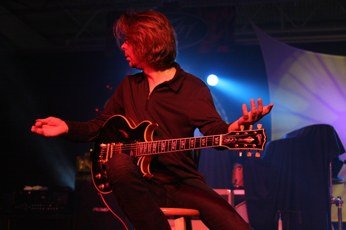
I also took a number of other pictures around the show. Other acts such as George Lynch, Rick Derringer, etc. were playing in 1 hour segments all day every day for two and a half days on the various stages. I couldn’t wait around for Phil Keaggy this time, though. There was a big free-for-all jam on Friday night. There were four stages inside and outside. The large Peavey Stage in the big echoing hall room, the Guitar Center stage, another outdoor stage, the acoustic stage (shown below), a clinic stage for experts to speak on techniques for playing or guitar repair or all kinds of guitar-related activities.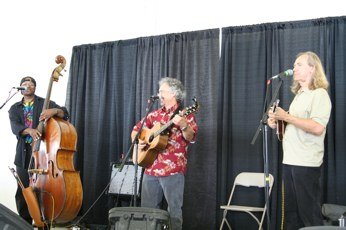
I did see a great, simple device called a “Sound Enhancer” for $200. It is basically a stand for a guitar amp that captures the sound coming out the back of the amp and reflects it underneath and shoots it out the front. It’s staggering the difference in sound depth and volume and quality. You can hear it as one man is playing through a small Fender vibrolux and his assistant lifts up the amp while he plays, and then lowers it onto the stand. The change is remarkable. If I start playing out on stage instead of in the studio, I will get one for my Vetta amp.
I did buy a couple of books of guitar-building and repair techniques, and also I picked up a strat body for only $50. I plan to rebuild my EJ Frankenstrat again. I got tired of just white, so I decided to go for a traditional sunburst look. I haven’t had a sunburst strat in over 20 years.
You may see some of the amazing guitars here in some of these photos. I found an exact replica of SRV’s beat-up old strat. The one worn down to the bare wood. Every detail was faithfully reproduced, including the curled-up sticker, and every scratch and gouge. 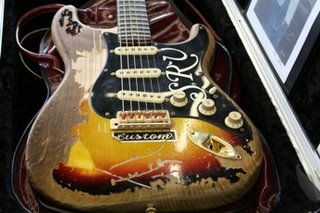 In fact, one boopth area of the show is the guitarist Hall of Fame, and Steve Ray Vaughan is shown in detail there with stories and pictures - and his original guitar is actually enshrined there in it's glass case, so it was easy to go back and forth and compare between the original SRV, and the extremely talented, clever reproduction.
In fact, one boopth area of the show is the guitarist Hall of Fame, and Steve Ray Vaughan is shown in detail there with stories and pictures - and his original guitar is actually enshrined there in it's glass case, so it was easy to go back and forth and compare between the original SRV, and the extremely talented, clever reproduction.
Also, I saw the Gibson Johnny A signature model. It is absolutely beautiful. It plays great and sounds fantastic. It's like an ES-336 small body, but has small devil-like horns instead of the rounded 335/336 horns. And it has a gorgeous flame sunburst finish, and a Bigsby tremolo installed at birth. Just excellent. What a work of art. It's one of the few guitars I'd still like to get. Not just to add to my collection, but to actually play - a LOT! My style has come to incorporate a tremolo bar quite a bit in the last 2 years, so having that combined with Gibson Custom Shop humbucker pickups would be very nice indeed.  Then there is the twin-necked PRS Double-Dragon, with incredibly ornate inlays of two fighting dragons in the body. This guitar is worth over $40,000.
Then there is the twin-necked PRS Double-Dragon, with incredibly ornate inlays of two fighting dragons in the body. This guitar is worth over $40,000. 
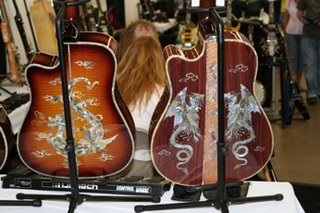 Or you can see the line of ‘50’s strats in every possible color each for $6300. Or there are the vintage Gibsons. The ES-335’ for around $25,000. The Les Pauls for $20,000 to $150,000. There is a 1961 3-pickup black Les Paul Custom that was for sale at $120,000. I have a white version of that exact same guitar. Mine is a 1989 and it’s in perfect condition. So it’s nice to know that if I keep it in good shape for a couple more decades, it will be worth that kind of money one day! Of course, by then, I couldn’t possibly part with it, so the actual price becomes somewhat academic, doesn’t it?
Or you can see the line of ‘50’s strats in every possible color each for $6300. Or there are the vintage Gibsons. The ES-335’ for around $25,000. The Les Pauls for $20,000 to $150,000. There is a 1961 3-pickup black Les Paul Custom that was for sale at $120,000. I have a white version of that exact same guitar. Mine is a 1989 and it’s in perfect condition. So it’s nice to know that if I keep it in good shape for a couple more decades, it will be worth that kind of money one day! Of course, by then, I couldn’t possibly part with it, so the actual price becomes somewhat academic, doesn’t it?
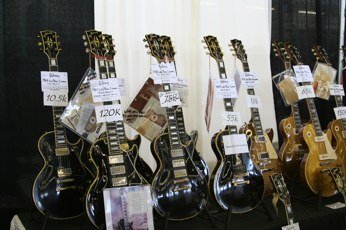
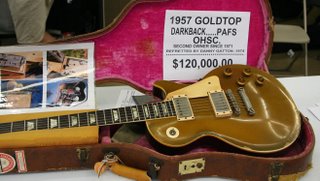
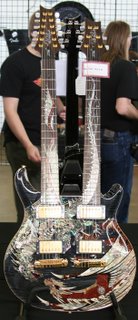
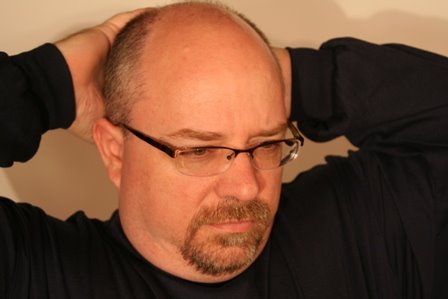

2 Comments:
You know, I never thought of going to a guitar festival just to see the guitars. But after reading about your collection and seeing these very fine photos, I would like to go to such a festival!
It is fun. But I have to admit, even for a diehard guitar fan, it does get to be too much guitar stuff after a while.
But I had a great time. I wish I could have seen more shows, actually.
Post a Comment
<< Home